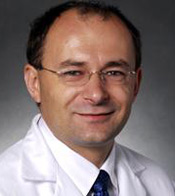小结
定义
病史和体格检查
关键诊断因素
- positive symptoms
- negative symptoms
- disorder of perception
- delusions
- disturbances in emotions
- incongruent affect
- disorders of stream and form of thought
- cognitive abnormalities
- deficit symptoms
- major depressive episodes
- manic episodes
其他诊断因素
- neurologic deficit
- family history
- functional impairment
- disorders of behavior
危险因素
- family history of schizophrenia
- substance use
- age of the father at patient's birth
- psychological stress
- environment
诊断性检查
首要检查
- urine drug screen
- sexually transmitted disease screening
- complete blood count
- thyroid function tests
需考虑的检查
- laboratory studies to exclude organic causes
- CT/MRI head
- electroencephalogram (EEG)
治疗流程
acute psychotic episode
multiple-episode disorder
撰稿人
作者
Adrian Preda, MD

Professor of Clinical Psychiatry
Department of Psychiatry and Human Behavior
University of California, Irvine School of Medicine
Irvine
CA
利益声明
AP was paid for consultancy work for GLG and Guidepoint.
Robert G. Bota, MD

Associate Clinical Professor of Psychiatry
University of California
Irvine
CA
利益声明
RGB declares that he has no competing interests.
鸣谢
Dr Adrian Preda and Dr Robert G. Bota would like to gratefully acknowledge Dr Bao-Nhan Benjamin Nguyen, who contributed to the updating of this topic.
利益声明
BN declares that he has no competing interests.
同行评议者
Kemal Sagduyu, MD
Professor of Psychiatry
University of Missouri Kansas City
Kansas City
MO
利益声明
KS declares that he has no competing interests.
William T. Regenold, MDCM
Associate Professor of Psychiatry
University of Maryland School of Medicine
Baltimore
MD
利益声明
WTR declares that he has no competing interests.
Peer reviewer acknowledgements
BMJ Best Practice topics are updated on a rolling basis in line with developments in evidence and guidance. The peer reviewers listed here have reviewed the content at least once during the history of the topic.
Disclosures
Peer reviewer affiliations and disclosures pertain to the time of the review.
参考文献
关键文献
Abrams DJ, Rojas DC, Arciniegas DB. Is schizoaffective disorder a distinct categorical diagnosis? A critical review of the literature. Neuropsychiatr Dis Treat. 2008 Dec;4(6):1089-109.全文 摘要
Harrow M, Grossman LS, Herbener ES, et al. Ten-year outcome: patients with schizoaffective disorders, schizophrenia, affective disorders and mood-incongruent psychotic symptoms. Br J Psychiatry. 2000 Nov;177:421-6.全文 摘要
Cheniaux E, Landeira-Fernandez J, Versiani M. The diagnoses of schizophrenia, schizoaffective disorder, bipolar disorder and unipolar depression: interrater reliability and congruence between DSM-IV and ICD-10. Psychopathology. 2009;42(5):293-8. 摘要
Jäger M, Haack S, Becker T, et al. Schizoaffective disorder: an ongoing challenge for psychiatric nosology. Eur Psychiatry. 2011 Apr;26(3):159-65. 摘要
Turner DT, van der Gaag M, Karyotaki E, et al. Psychological interventions for psychosis: a meta-analysis of comparative outcome studies. Am J Psychiatry. 2014 May;171(5):523-38. 摘要
National Institute for Health and Care Excellence. Psychosis and schizophrenia in adults: prevention and management. March 2014 [internet publication].全文
参考文献
A full list of sources referenced in this topic is available to users with access to all of BMJ Best Practice.
鉴别诊断
- Schizophrenia
- Substance-induced psychotic disorder
- Dementia with psychosis
更多 鉴别诊断指南
- Diagnostic and statistical manual, 5th edition, text revision (DSM-5-TR)
- International statistical classification of diseases and related health problems, 11th revision (ICD-11)
更多 指南患者教育信息
Schizoaffective disorder
更多 患者教育信息登录或订阅即可浏览 BMJ Best Practice 临床实践完整内容
内容使用需遵循免责声明